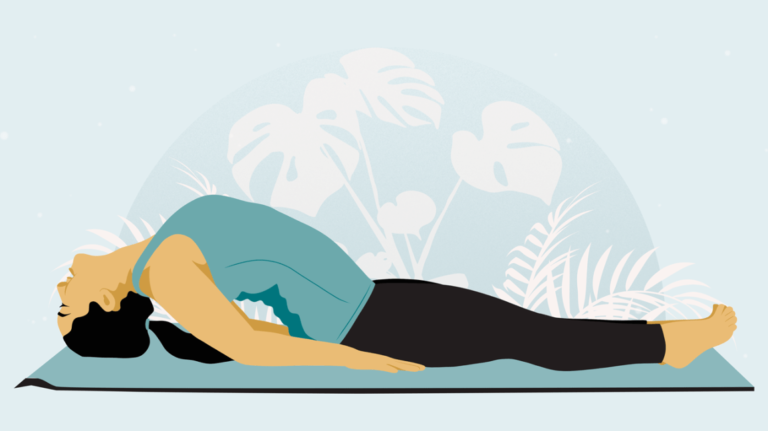
Yoga nidra, also referred to as yogic sleep, is one of the simplest yoga practises to establish and sustain and is a tremendously effective meditation technique. This methodical meditation progresses through the pancha maya kosha (five layers of self) as the practitioner is lying peacefully in savasana (corpse pose), leaving them feeling complete. You won’t have to fear waiting for liberty while lying on the ground for hours. These are five advantages to starting a yoga nidra routine.

YOGA NIDRA CAN BE DONE BY ANYONE
Not everyone enjoys slow asana holds and fast vinyasa flows. But everyone can practise yoga nidra, from young toddlers to elderly people. Any age can follow it easily. Your body only needs to lay flat on the ground. Also, you can perform this exercise while sitting if you are unable to lie on the ground.
“Yoga Nidra” is a practise that everyone can engage in, whether they are young or old.
- Yoga Nidra cannot be practised improperly.
All you need to do is listen to the voice guiding you as you lie supported in savasana. It’s likely that you’ll recall certain meditation-related details but not others. You have a different experience each time you visit the practise, and each one is valid. It’s acceptable to doze off since you will still benefit from the practise while your unconscious mind absorbs it. - It’s simple to include yoga nidra into your daily life.
Trying to focus, find inspiration, or bring awareness back to the breath during seated meditation can be challenging. There is never deep pondering or wondering why you are staring at a blank wall in yoga nidra because it is always guided. Yoga nidra sessions might last anything from five minutes to an hour. You get to pick the length. Making a yoga nidra practise a part of your nightly bedtime ritual might be the simplest way to fit one in. Turn on the headphones, do some practising in bed, and then go to sleep. Even if it’s not the most traditional method, if you’re going to be lying down anyhow, there’s no reason you shouldn’t practise yoga nidra.
QUICK AND EASY WAY TO DECREASE STRESS
Yoga nidra encourages restful sleep and relaxation in a way that traditional meditation doesn’t. To relax the nervous system and promote less stress and greater health, one can practise the phases of body scan and breath awareness alone.
Yoga Nidra gives you the chance to have a deeper understanding of who you are.
While some practitioners use the safe, nonjudgmental environment that yoga nidra offers as a window into themselves, others enjoy the tremendous relaxation that this practise instills. Yoga nidra gives you a place to consider what you need right now and a chance to focus on letting go of long-repressed emotions. You can experience an emotion and “front” what you want to overcome while in a yoga nidra session without “falling into it totally” or feeling the emotion to the point that you’re overwhelmed. You continue to feel the emotion and related feelings as you get further in the practise.
Yoga nidra gives you a place to consider what you need right now and a chance to focus on letting go of long-repressed emotions.
Yoga nidra can offer a route to liberation without putting physical strain on the body. A habit or repeating thought that becomes more deeply ingrained in the mind and body over time, forming a mental impression (groove), is known as a samskara (mental groove). These perceptions may elicit unfavourable feelings and reactions, which hinder the unity of one’s five koshas. The mental/emotional layer of the self cannot unite with the other layers—physical, energetic, higher wisdom, and bliss body—if these unfavourable emotions continue to bother you. Yoga nidra can be extremely beneficial in this situation.
An aim in the yoga nidra practise can be a samskara. It’s possible that you enter the practise knowing exactly what you want to work on. Then, at the start of the practise, the intention is set, frequently at the teacher’s prompting. Thus, when a samskara appears during practise, you can address the feelings that come up and then give yourself permission to feel them more and more. With each consecutive practise, you delve deeper into a samskara, gain a better understanding of your response, and eventually can let the samskara to release into the ocean of consciousness by using this technique (and feeling secure during the voyage). It is no longer a lasting impact at that moment. You are free of that samskara now!
You’re aware now! Yoga nidra is a simple meditation technique that emphasises developing various degrees of wellbeing. If you practise consistently and with awareness, you might find that you can find a significant level of calm in a short amount of time.
Yoga Nidra and its BENEFITS
These are only two of the many health issues that society deals with on a daily basis. What if, however, we were to inform you that there is a workable answer to all of these issues and many more?
Yoga Nidra, sometimes referred to as yogic sleep, is a form of meditation that has been practised since the seventh and sixth centuries, far before the common era and Buddhism. Body, mind, and soul are all profoundly healed by the special meditation technique.
Brain waves that are transitioning into sleep start off as thoughtful beta waves, move through alpha wave phases, then theta wave stages, and eventually reach the slowest frequency of sleep, delta wave stages. Yoga Nidra leads users into a relaxed state that is between between the alpha and theta states. As a result, we can lie in a state of deep relaxation in between waking and sleeping.
The autonomic nervous system, which controls bodily functions carried out automatically, is calmed by this state. Moreover, it induces a deeper resting state in the parasympathetic nervous system. Guided meditation has profound advantages for both the brain and body because it calms the nervous system.
Yoga Nidra is one of the simplest forms of yoga, although it has a wide range of advantages. You simply need to put on your cosiest clothes, look for a peaceful area, lie down in corpse position, and play your sleep meditation music.
Read on to discover seven incredible advantages of yoga nidra that could help you feel better.
BETTER THOUGHT FORMATS AND LESS STRESS
Through guided meditation, Yoga Nidra helps you achieve a soothing condition for both your body and mind. The exercise alters brain waves through physical and mental activities, which releases emotional tension, calms the nervous system, and promotes muscle relaxation. As a result, stress levels in the body and mind are naturally reduced. Headaches and muscle tension can be relieved by reducing physical and mental stress.
Neural connections that have become stronger over time are thought patterns. Similar to retraining a muscle, changing the patterns is quite difficult due to the strength of these linkages. Yoga Nidra induces an altered state of consciousness that teaches the brain to access thought patterns from a totally different angle. You are able to watch your ideas from a distance rather than becoming fully immersed in them. You can retrain your cognitive processes using this new perspective.
IMPROVED MEMORY AND COGNITIVE PERFORMANCE
By making room in the brain, yoga nidra practise enhances cognitive performance. It does this by assisting in stress reduction. When the mind is overloaded with emotions, it has limited room to carry out daily tasks effectively. Stress is lessened, allowing the brain to do tasks to the best of its ability. Yoga Nidra can be used to alleviate stress and assist in removing unrelated ideas from the conscious mind.
Regular practitioners of Yoga Nidra have also reported improvements in their memory. It enhances attention and prevents aging-related cognitive deterioration. Through regular practise, you can raise your mental performance, which will help you complete daily chores more quickly.
RENEWED CONFIDENCE AND SELF-ESTEEM
Yoga Nidra practise on a regular basis can significantly boost your confidence and self-worth. Recent research from two Turkish colleges lends credence to this assertion. The results of the study, which examined how Yoga Nidra affected burn patients’ perceptions of their bodies and their own worth, showed that the experimental group significantly improved in these areas.
Setting your own intentions is a crucial step in guided meditation. Sankalpa refers to these objectives, which are your heart’s desires and the targets you set for yourself. Determining your intentions can help you accomplish personal growth and progress, which is quite satisfying. Your self-esteem and confidence will improve as a result of achieving your goals.
BETTER SLEEP AND BETTER HYPERTENSION
Yoga Nidra is very effective for enhancing your sleep quality and schedule. Man doing yoga nidra on wooden floor. By making it easier for you to fall asleep at night, stay asleep longer, and get a full night’s rest, it aids in the development of regular sleep habits. Furthermore, it aids in the treatment of sleep disorders such insomnia and sleep deprivation.
You can quiet the brain and body to improve your sleep cycle with regular practise and learning how to relax your body and mind. It’s essential to enter a deep sleep state if you want to enhance your physical health and wellbeing. For additional information, check our articles on Yoga Nidra for Sleep.
BETTER AWAKENING OF MINDFULNESS
Being mindful is the quality and state of being present in every moment of our existence. By totally embracing the present, it rejects thinking about the past and the future. Instead of evaluating thoughts or denying what is happening around you, mindful thinking places an emphasis on acceptance of the events that are occurring right now.
Your mind will calm down and lull you to sleep during yogic slumber. You will learn to acknowledge when thoughts enter your head and how to let them go here. You can incorporate mindfulness into your daily life by becoming more profoundly aware. You will be able to access a better waking state as a result.
REDUCES ANXIETY AND DEPRESSION Symptoms
High vigilance, a hyperactive brain, persistently unpleasant thoughts, and other pressures are symptoms of anxiety disorders. Our mental reaction patterns, which are the cause of suffering, can make routine daily tasks challenging. Yoga Nidra fosters a deep state of physical and emotional relaxation, which reduces the signs and symptoms of anxiety.
Also, the age-old practise lets go of repressed feelings and tension to cleanse the brain. Yogic sleep efficiently reduces stress so that you can access thought patterns in a new condition and even change them so that you become more accepting of the variations in daily life. Removing negative thoughts from the subconscious mind lowers the likelihood of developing depression and other psychological issues as well as their signs and symptoms.
treats post-traumatic stress disorder and chronic pain
In order to silence the areas of the brain that are in charge of unpleasant thoughts and feelings, Richard Miller, the creator of iRest, created a number of contemporary modifications to the Yoga Nidra technique. U.S. officials encouraged using Yoga Nidra as a kind of treatment for persistent pain. In order to cure persistent pain and post-traumatic stress disorder, the Army Surgeon General (PTSD). Yogic sleep induces a deep level of relaxation in the practitioner, which makes them feel rested. The nervous system is slowed by this tranquil state, giving the body time to recuperate. The body can relax, heal, and regenerate here. Yoga Nidra also enhances immune system performance and lowers inflammation to effectively treat chronic pain.
GUIDED YOGA NIDRA ALSO HAS THE FOLLOWING ADVANTAGES:
brings down blood pressure.
decreases reliance.
improves artistic ability.
decreases PTSD.
increased immunological capacity.
lowers a person’s cholesterol.
refuels the body’s energy.
the nervous system is balanced.
reduces irregular menstruation
increases endocrine system strength.
decreases the need for painkillers.
Practice Yoga Nidra many times a week for optimal effects. You can access the significant advantages of Yoga Nidra through the therapeutic healing process with regular practise, even if it just lasts a few minutes every day.
You can feel refreshed, at ease, and energetic with the aid of yoga nidra. Your emotions, feelings, and more can all be affected. When performed carefully and intentionally, the guided meditation is incredibly therapeutic. Yoga Nidra can be helpful if you have a mental problem, endure chronic pain, or just want to enhance your general health and wellbeing.


